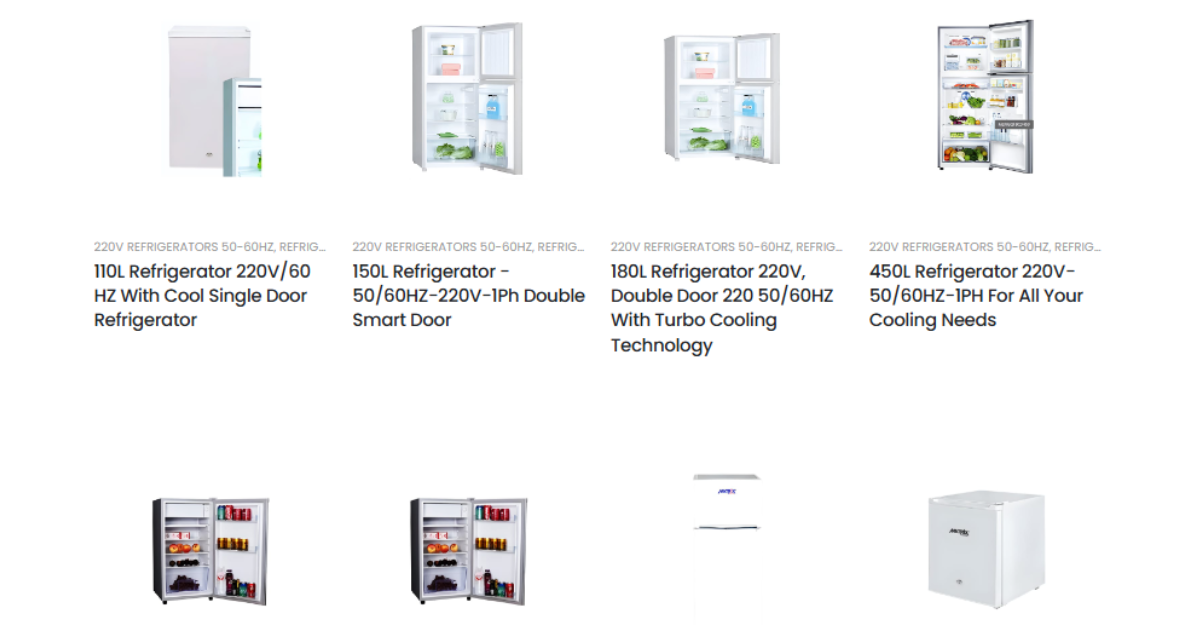The Silent Hum: Understanding the Impact of Running a 50Hz Fridge on a 60Hz Power Supply
50Hz Fridge On 60Hz: For many, the hum of a refrigerator is a reassuring sound, a sign that our food is being kept safe and fresh. But what happens when that hum is slightly off-key, when the very electricity powering your appliance isn’t quite what it was designed for? This is the perplexing, and often problematic, scenario of running a 50Hz refrigerator on a 60Hz power supply. While it might seem like a minor difference, the implications can range from reduced efficiency and premature wear to outright appliance failure.
At Royal Light LLC, we believe in empowering our customers with knowledge. Understanding the intricacies of electrical compatibility is crucial, especially in a world where appliances are often imported or moved across regions with differing electrical standards. This comprehensive guide will delve into the technicalities of frequency, explain why a 50Hz fridge struggles on a 60Hz supply, outline the potential risks, and offer practical advice to ensure the longevity and safe operation of your valuable appliances.
Unpacking the Hertz: What Exactly is Frequency?
Before we dive into the specific challenges, let’s clarify what “Hertz” (Hz) truly represents. In the context of alternating current (AC) electricity, frequency refers to the number of times the direction of the current reverses per second. Think of it like a wave: 50Hz means the wave completes 50 cycles (reverses direction 50 times) every second, while 60Hz means it completes 60 cycles per second.
This difference in cycles per second is a fundamental characteristic of the electrical grid in various regions. North America, for instance, primarily operates on a 60Hz system, whereas much of Europe, Asia, Africa, and Australia utilize a 50Hz system. Appliances are meticulously designed to operate within the parameters of their intended frequency, and deviations can have significant consequences.
The Heart of the Matter: How Frequency Affects Your Fridge’s Motor
The most critical component in a refrigerator affected by frequency discrepancies is its compressor motor. This motor is the workhorse of your fridge, responsible for circulating the refrigerant and facilitating the cooling process.
Induction Motors and Synchronous Speed: Most refrigerator compressors use induction motors. The speed at which an induction motor rotates (its synchronous speed) is directly proportional to the frequency of the power supply and inversely proportional to the number of poles in the motor. The formula for synchronous speed (Ns) is given by:
Ns=(120×f)/P
Where:
- f = frequency in Hertz
- P = number of poles in the motor
If a motor designed for 50Hz (meaning its internal windings and number of poles are optimized for 50 cycles per second) is suddenly fed with 60Hz power, its theoretical synchronous speed will increase. For example, a 4-pole motor designed for 50Hz would have a synchronous speed of (120 * 50) / 4 = 1500 RPM. On a 60Hz supply, the same motor would attempt to run at (120 * 60) / 4 = 1800 RPM.
The Ripple Effect: Beyond Just Speed: This increase in motor speed might seem beneficial at first glance, but it’s far from it. It sets off a chain reaction of negative impacts:
- Increased Current Draw: To achieve this higher speed, the motor will draw more current than it was designed for. This excessive current leads to increased heat generation within the motor windings.
- Overheating and Insulation Breakdown: The prolonged overheating can cause the insulation around the motor windings to degrade rapidly. Once this insulation breaks down, it can lead to short circuits and permanent motor failure.
- Compressor Strain and Reduced Lifespan: The compressor itself, connected to the motor, is also designed for a specific operating speed and pressure range. Running at a higher speed puts undue mechanical stress on its internal components, including pistons, valves, and bearings. This accelerates wear and tear, drastically shortening the lifespan of the entire compressor unit.
- Inefficient Cooling: While the motor runs faster, it doesn’t necessarily translate to more efficient cooling. The refrigerant system is a finely tuned balance of pressure, temperature, and flow rates. A faster compressor might move refrigerant more quickly, but it can disrupt the thermodynamic cycle, leading to suboptimal heat exchange in the evaporator and condenser coils. Your fridge might struggle to maintain consistent temperatures, leading to food spoilage.
- Increased Noise and Vibration: The accelerated operation and mechanical stress can manifest as louder operation and increased vibration from the appliance. This is not only annoying but also a clear indicator of internal strain.
- Reduced Energy Efficiency: Despite drawing more current, the overall cooling efficiency often decreases. This means your 50Hz fridge running on 60Hz power will consume more electricity to achieve potentially less effective cooling, leading to higher energy bills.
More Than Just the Motor: Other Components at Risk
While the compressor motor is the primary concern, other electrical components within the refrigerator can also be adversely affected by a frequency mismatch:
- Transformers: If the fridge contains internal transformers (for control boards, display lighting, etc.), their impedance is also frequency-dependent. Running on a higher frequency can alter their characteristics, potentially leading to overheating or improper voltage delivery to sensitive electronics.
- Capacitors: Some motor starting circuits and power factor correction circuits utilize capacitors. While capacitors are generally more tolerant of frequency variations than inductive components, significant deviations can still affect their performance and lifespan.
- Timers and Control Boards: Older, simpler refrigerators might use electromechanical timers that rely on the AC frequency for accurate timing. A 60Hz supply would cause these timers to run faster, throwing off defrost cycles and other timed functions. More modern refrigerators with electronic control boards are generally more robust due to their internal DC power supplies, but excessive heat from other components can still impact their longevity.
Identifying the Risk: Is Your Fridge a 50Hz Appliance?
The easiest way to determine the operating frequency of your refrigerator is to check the manufacturer’s label or nameplate. This is usually located inside the fridge compartment, on the back of the unit, or sometimes on the side. The label will clearly state the required voltage (V) and frequency (Hz). For example, it might say “220-240V ~ 50Hz” or “110-120V ~ 60Hz”.
If you’re unsure, and especially if you’ve purchased an appliance from a different region or are moving to a country with a different electrical standard, it’s crucial to verify this information before plugging it in.
The Solution: What to Do if You Have a Mismatch
If you find yourself in a situation where your 50Hz fridge needs to operate on a 60Hz power supply, or vice-versa, there are generally three courses of action:
-
Use a Frequency Converter (Transformer with Frequency Conversion): This is the most effective and safest solution for critical appliances like refrigerators. A frequency converter (sometimes called a rotary converter or a static frequency converter) is a specialized device that takes the incoming power (e.g., 60Hz) and converts it to the desired frequency (e.g., 50Hz) while also adjusting the voltage if necessary. These are robust solutions designed for continuous operation and ensure your appliance receives the precise power it needs. However, they can be a significant investment, especially for larger appliances.
-
Purchase a New Appliance: In many cases, especially for smaller or older refrigerators, investing in a frequency converter might be more expensive than simply purchasing a new refrigerator designed for the local power supply. This is often the most practical and long-term solution, ensuring full compatibility and optimal performance.
-
Avoid Using the Appliance: If neither of the above options is feasible, and you are dealing with a critical appliance like a refrigerator, it is strongly advised not to run a 50Hz appliance on a 60Hz supply. The risks of damage, premature failure, and potential safety hazards (due to overheating) far outweigh any short-term convenience.
Why Royal Light LLC Emphasizes Electrical Compatibility
At Royal Light LLC, our expertise lies in understanding the nuanced world of electrical systems and ensuring the safe and efficient operation of all your electrical installations. While we specialize in a broad range of services, the principle of proper electrical compatibility underpins everything we do.
Running a mismatched appliance isn’t just about the appliance itself; it can also put undue strain on your home’s electrical wiring and circuit breakers, potentially leading to tripped breakers or, in severe cases, even electrical fires if the wiring is undersized or faulty. Our commitment is to provide solutions that are not only effective but also prioritize safety and long-term reliability.
Conclusion: Don’t Compromise on Electrical Integrity
The difference between 50Hz and 60Hz might seem minor, but for a 50Hz refrigerator, operating on a 60Hz power supply is akin to asking a finely tuned instrument to play a piece at a much faster tempo than it was designed for. The result is strain, inefficiency, and ultimately, breakdown.
Before you plug in an imported appliance or move your existing refrigerator to a new region, take a moment to verify its electrical specifications. Understanding and respecting the design parameters of your appliances is key to their longevity and your peace of mind. When in doubt, consult with electrical professionals like us at Royal Light LLC. We can help you assess your needs, understand the implications, and guide you towards the safest and most efficient solutions, ensuring your appliances hum along harmoniously for years to come.
Frequently Asked Questions (FAQ)
Q1: Can I just use a regular voltage converter (step-up/step-down transformer) for a 50Hz fridge on a 60Hz supply? A1: No, a standard voltage converter (transformer) only changes the voltage, not the frequency. While it might correct the voltage, the frequency mismatch will still cause the motor and other components to operate incorrectly, leading to the problems described in the blog post. You need a dedicated frequency converter.
Q2: Will my 50Hz fridge immediately break if I plug it into a 60Hz outlet? A2: Not necessarily immediately, but the damage will start occurring from the moment it’s plugged in. The motor will draw more current, generate more heat, and experience increased mechanical stress. The degradation is cumulative, leading to premature failure over time, which could be weeks, months, or even days depending on the appliance’s build quality and operating conditions.
Q3: What are the tell-tale signs that my 50Hz fridge is struggling on a 60Hz supply? A3: Common signs include the fridge running louder than usual, excessive vibration, the compressor running more frequently or for longer periods, the fridge not cooling effectively, or higher than expected electricity bills for the appliance. In severe cases, you might notice a burning smell from the motor area.
Q4: Is it safe to run a 50Hz fridge on 60Hz power, even if it’s just for a short period? A4: It is generally not recommended. While a very brief period might not cause immediate catastrophic failure, any operation under mismatched frequency conditions will contribute to accelerated wear and tear and potential damage. The risk of overheating and electrical hazards also increases. It’s always best to ensure proper electrical compatibility.
Q5: What if my fridge is “dual frequency” (e.g., 50/60Hz)? A5: If your refrigerator’s nameplate explicitly states “50/60Hz,” then it is designed to operate safely and efficiently on either frequency. These appliances have motors and control systems that can adapt to both power standards. Always check the label to confirm.
Q6: Does this issue also apply to other appliances like washing machines or air conditioners? A6: Yes, absolutely. Any appliance with an AC induction motor (like washing machines, dryers, air conditioners, fans, pumps) will be affected by frequency mismatches in a similar way, experiencing issues with speed, efficiency, and lifespan. Appliances with purely resistive loads (like heaters, toasters, kettles) are generally less affected by frequency, as long as the voltage is correct. However, any internal electronics or motors within these appliances would still be vulnerable.
Q7: Can a local electrician modify my 50Hz fridge to work on 60Hz power? A7: Modifying the internal components of a refrigerator to change its operating frequency is a highly specialized and complex task, often not practical or cost-effective. It would typically involve replacing the motor and potentially other electrical components. It’s usually far more practical to use a frequency converter or replace the appliance. Always consult with a qualified electrical professional for advice, but be wary of simple “fixes” for frequency conversion.
Read More







